
5-15 supporting friends (round but not terribly in-depth). 1-5 best friends (read, main/prominent round characters). When working on your story, the Dunbar number can be used as a good guide for ratios of round : flat Sometimes it can be used well to get a point across, but it hasn’t been a well-received mode of narrative since the genesis of the novel in the 1700s. A story comprised of only flat characters, however, is just boring. No one can get a cohesive thought across and everyone ends up exhausted. Writing only round characters is the equivalent of pulling your reader into a crowded party where everyone is talking loudly and vying for the reader’s attention. 
What Place do Flat and Round Characters have in a Story? The change doesn’t have to be radical to make a character round, but once you stray from a character’s whole identity being tied to a single trait or concept, they are no longer flat. There is nuance to his motivations and personality and, above all, he changes throughout the series. To carry on with the Harry Potter example, Malfoy is a round character because he is built around more than a single idea or feature.
“Capable of surprising in a convincing way” -E.M. They are built to be Malfoy’s lackeys and they never are or become more than the dumb, mean-spirited boys that we meet in the Sorcerer’s Stone. Rowling’s Crabbe and Goyle are good examples of flat characters. Shallow (as in the reader only sees the surface). 
Let’s begin with looking at what flat and round characters are. When you’re strategic in your placement of flat and round characters, you can create a focused, textured story that feels grounded in reality no matter how many dragons crawl through its pages.

Writing is a balancing act of complements and contrast.







 0 kommentar(er)
0 kommentar(er)
